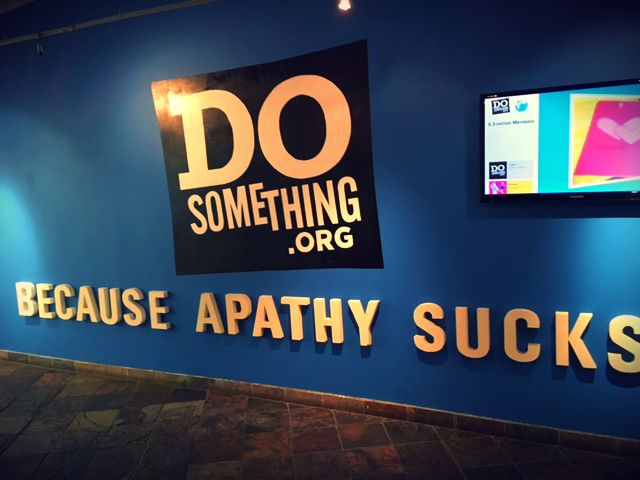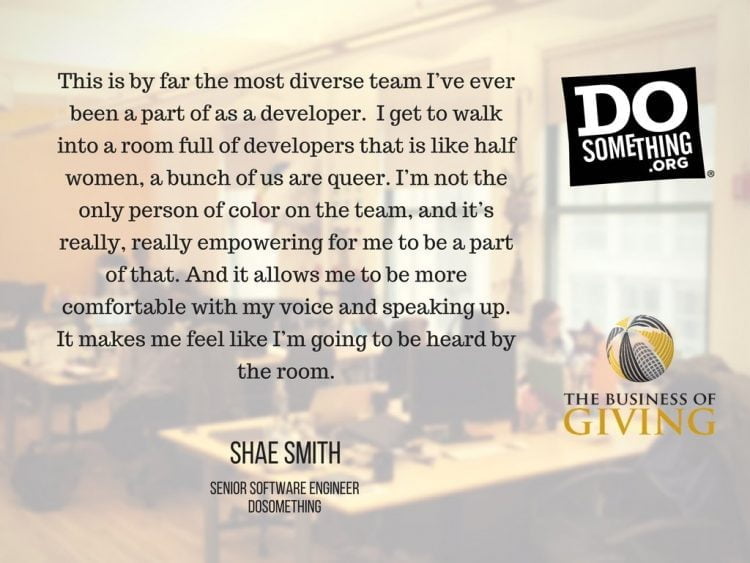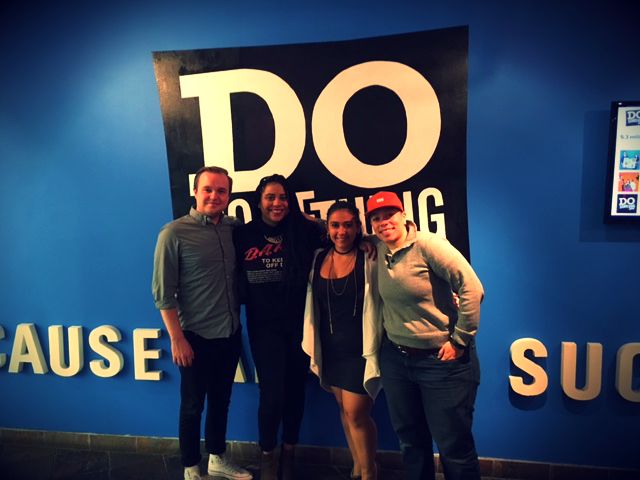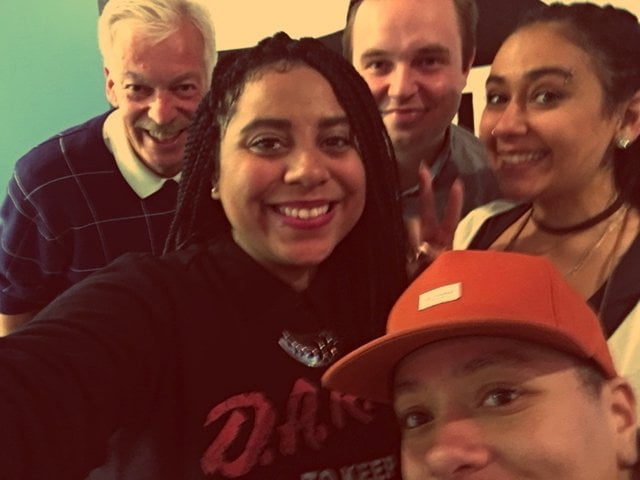
DoSomething CEO Aria Finger and Denver Frederick
Transcript
Denver: And we’ll now travel to West 21st St. in Manhattan into the offices of DoSomething.org. DoSomething, which is the largest global organization in the world for young people and social change, is consistently listed as one of the best places to work in either the profit or nonprofit sector and you will soon find out why. We’ll start with their CEO, Aria Finger, in celebrating and learning from failure, and then hear from the members of the staff.
Aria: So, twice a year, we hold a FailFest, and you are nominated by your manager to present— but when you do, you must wear a pink boa, and you must give three learnings that you had from this failure… and three learnings that the organization had. Each of these learnings must be accompanied by a pop culture corollary. This is to keep the afternoon light and fun and in a mode of learning…as opposed to feeling ashamed and sweeping that failure under the rug. It’s been a really excellent way to both normalize talking about failures that we’ve had in the past, but also to really spot talent… to really see, “Oh, wow….that employee analyzed the failure, thought of new ideas, and really has a plan for the future.” So instead of being a bad thing to present at FailFest, it can actually turn into a positive.

Greg: One of the stories that really embody our culture in my mind is how we celebrated when DoSomething.org surpassed the 3 million member mark. So we’re a nonprofit, we don’t have a ton of resources for big celebrations or big parties, but the leadership team gave every staff member $100 to spend in a way that would benefit the organization or prank the organization or just contribute to this celebratory atmosphere. We had people do everything from pool their money to buy a foosball table for the office to one of our teammates who hid 100 $1 bills all around the office so that people we’re finding them for weeks and just being excited to find money under a cabinet or something like that. It was a great way to celebrate. It empowered everyone to feel like part of the accomplishment and it got us really excited to keep moving and keep recruiting more young people to take action for social causes.
Kayla: One thing that we do is every Tuesday, we have something called “Toto Tuesday.” How that works is at 5:30 on the dot every Tuesday, on the Sonos speakers for everyone to hear at a very loud volume that is inconvenient for everyone is Toto’s Africa, and the point is to try to get people to leave the office on time on Tuesdays. I think specifically, too, with the nonprofit world, you’re working later hours than usual, so it’s just a push to get people out on time to go live their lives; and nobody wants to listen to Toto’s Africa on repeat, so it’s very effective.
Adam: Every three to four months, names are thrown into a hat and they’re drawn out at random, and that’s important because the order your name comes out of that hat is the order in which you get to choose where your desk is. We have an entirely open office, which means the CEO sits next To associates which means directors sit next to managers. In fact at my pod, at my seat, I sit right across from our chief data officer and right next to our CTO and right across from someone on our finance team.
So despite being on the campaigns team, I actually don’t sit anywhere near other campaigns team member. It actually encourages people to meet people and to get out of the bubble of their own department. Also some of the best collaboration that I’ve had here has come out of that.
 Shae: One thing we do at DoSomething is we have a staff meeting every Wednesday and at the staff meeting, everybody goes around and says one thing they accomplished, one goal for the next week, and any requests that they have from the room. And then at the end of the staff meeting, we have the ritual of giving somebody the penguin, which is an actual literal stuffed animal penguin that the person who got it the week before gives to another member of the staff. The idea is to give it somebody who hasn’t gotten it in a while, not to give it to somebody who’s like a direct report or your manager. So people really reach across different teams and you tell them why they deserve it: it’s usually somebody who’s completed a really big project; it’s somebody who’s done something really cool; or who has, overall, been a really, really important asset to the team and has been performing really well. It’s just a really good way to have that kind of shout out and know that other people in the org recognize you for your work.
Shae: One thing we do at DoSomething is we have a staff meeting every Wednesday and at the staff meeting, everybody goes around and says one thing they accomplished, one goal for the next week, and any requests that they have from the room. And then at the end of the staff meeting, we have the ritual of giving somebody the penguin, which is an actual literal stuffed animal penguin that the person who got it the week before gives to another member of the staff. The idea is to give it somebody who hasn’t gotten it in a while, not to give it to somebody who’s like a direct report or your manager. So people really reach across different teams and you tell them why they deserve it: it’s usually somebody who’s completed a really big project; it’s somebody who’s done something really cool; or who has, overall, been a really, really important asset to the team and has been performing really well. It’s just a really good way to have that kind of shout out and know that other people in the org recognize you for your work.
Adam: If there’s ever a conversation about which way we should go or what way we should run a campaign or what thing we should prioritize, something that will literally be said in meetings is, “We need to fight for the user. What’s the best thing for our members? What’s the best thing for the 5.4 million young people that we want to give to them to make their world a better place?” Everything else is secondary to that. I mean those words are now branded on my brain. “Fight for the user” is one of the first things I think of when I wake up in the morning, for better or worse.
Sam: I think one of the pieces of our secret sauce here that so many places underutilize and I’m almost hesitant to share it, but it’s really our interns. We have a phenomenal internship program, the best that I’ve ever seen. We actually treat our interns so well and they love us so much that a quarter of our staff is former interns and we try to keep it at that number, that sweet spot, because we know that our interns are the best in the game. We’ve crunched the numbers and it’s harder to get an internship at DoSomething.org than it is to get into Harvard and we like to brag about that.
Shae: One of the things I love about working on the tech team at DoSomething – I have previously worked at a for-profit organization, corporate organization as a developer, I’ve worked at another nonprofit – this is by far the most diverse team I’ve ever been a part of as a developer. Being in spaces where I’ve been the only woman of color, the only queer person in the room, it’s very isolating and it’s very hard to succeed. I get to walk into a room full of developers that is like half women, a bunch of us are queer. I’m not the only person of color on the team, and it’s really, really empowering for me to be a part of that and it allows me to be more comfortable with my voice and speaking up. It makes me feel like I’m going to be heard by the room.
Kayla: I think the culture at DoSomething and something that makes it so special is that everyone who works here plays a part in the culture of DoSomething. One way that we make sure that happens is every six months, we do a staff survey with very detailed questions, very specific questions to find out staff happiness, to sort of see what areas in office culture and office happiness that we’re lacking, and also just to see how we can improve on this.
I think every person who works at DoSomething has affected the culture in one way or another.

Adam: One of the great things about the rituals here at DoSomething is we don’t know where a lot of them came from. I mean that’s one of the strange, weird things about rituals. If you ask me to describe where Christmas came from and why we have a Christmas tree in the middle of our home every December – or most of our homes – I couldn’t tell you but there’s a certain weight behind them. I’m someone who’s been here for only a year and a half and has now experienced all the various rituals, but they work because they have weight.
Shae: I think one thing that I’ve always enjoyed about DoSomething is that from the moment you’re hired or being hired, during the interview process to the moment that you work here and to the moment you leave, you’re evaluated and you’re thought of based on who you are and what you can do. I think sometimes you work in organizations where people evaluate you based on your output, based on the work that you do but don’t think of you as a full person. I think what’s critical is that every employee is seen as a human who has a life outside of work, who has interests outside of work, who can bring that all to the room when they come to their job and they sit at their desk, so they’re not leaving parts of themselves behind.
Sam: Although we always want constant feedback to be given, it’s really nice to know that every three months, you have the ability to sit down with your manager in a room and say like, “This is what I really want to work on; this is what was super helpful that you did last quarter; and this is what I think I need some more coaching in,” and not going 11-1/2 months in between knowing how well you’re doing or where you stand in the organization, and so you always know what you should be working on and when to pivot. I think it just is a testament to how well we’re able to innovate and how quickly we’re able to move because we are constantly aware of kind of where we fit in the larger mission of the organization.
The Business of Giving can be heard every Sunday evening between 6 and 7 PM Eastern on AM 970 The Answer in New York and on I Heart Radio. You can follow us at bizofgive on Twitter and at facebook.com/businessofgiving.


